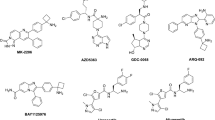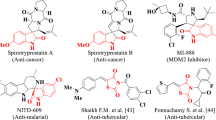Abstract
A series of novel 4-(2-isonicotinoylhydrazono)-4-aroylbutanoic acid derivatives (3a-n) were designed, synthesized and characterized by 1H-NMR, 13C-NMR, and mass spectroscopic analyses. The synthesized compounds evaluated for anti-tubercular activity against various M. tb strains showed potent anti-tubercular activity with MIC = 1 µg/ml for 3a, 3b, 3i and 3j against both H37Ra and H37Rv M. tb strains. MBC demonstrated that the synthesized compounds showed good bacteriocidal effect against both H37Ra and H37Rv M. tb strains with equivalent MIC and MBC values. All the compounds were found moderately active against the INH-resistant clinical isolates of M. tb with MIC 64 µg/ml. The most active compounds of the series (3a, 3b and 3i) were evaluated as non-cytotoxic towards normal human cell lines. In-silico docking studies and binding interactions of the synthesized compounds and INH revealed binding affinity towards the active site of the protein target M. tb InhA complexed with NADH (PDB ID: 4DRE). Among the most active compounds, 3a exhibited better binding affinity of -7.798 kcal/mol as compared to standard, INH (−6.925 kcal/mol). Compound 3a displayed hydrogen bonding between nitrogen of the pyridine ring and NH of VAL 65 and aromatic hydrogen bonding with C = O of LYS 63. Both phenyl ring and pyridine ring of the compound 3a exhibited π-π stacking interactions with phenyl ring of PHE 41 and hydrogen bonding between carboxylic oxygen of compound 3a and SER 20. Physicochemical properties and pharmacokinetic profiling assessed for the synthesized compounds were found to follow Lipinski’s rule using Swiss ADME online prediction tools. These findings make them promising candidates for the future development of new anti-tubercular agents.
Highlights
-
4-(2-Isonicotinoylhydrazono)butanoic acid derivatives 3a-n were designed, synthesized and evaluated against avirulent (H37Ra), virulent (H37Rv) and Isoniazid-Resistant clinical isolates of M. tuberculosis (M.tb).
-
Compounds showed moderate to good anti-tubercular activity against avirulent, virulent as well as the drug resistant clinical isolates of Mycobacterium tuberculosis (M.tb).
-
MBC of the synthesized compounds exhibited similar values for both avirulent (H37Ra) and virulent (H37Rv) strains.
-
Molecular docking studies of the compounds using protein target Mycobacterium tuberculosis InhA in complex with NADH (PDB ID: 4DRE) determined binding interactions of the synthesized compounds with the protein target.
-
The cytotoxicity of the most active compounds of the series (3a, 3b and 3i) evaluated based on percentage viability against three normal human cell lines including Human Embyonic Kindey cell line (HEK-293), Murine Hepatocyte cell line (AML12) and Lung Macrophage cell line (RAW-264) showed least percentage growth inhibition at different concentrations making the compounds nontoxic even upto 1000 µM.
-
Physicochemical properties, pharmacokinetic profile and drug likeness studies of the synthesized compounds using Swiss ADME online prediction tools.








Similar content being viewed by others
References
Bhalerao MB, Dhumal ST, Deshmukh AR, Nawale LU, Khedkar V, Sarkar D, et al. New bithiazolyl hydrazones:, Bioorg Med Chem Lett. 2016. https://doi.org/10.1016/j.bmcl.2016.11.056.
Chakaya J, Khan M, Ntoumi F, Aklillu E, Fatima R, Mwaba P, et al. Global Tuberculosis Report 2020 – Reflections on the Global TB burden, treatment and prevention efforts. Int J Infect Dis. 2021;113:S7–S12. https://doi.org/10.1016/j.ijid.2021.02.107.
Atta A, Fahmy S, Rizk O, Sriram D, Mahran MA. Structure-based design of some isonicotinic acid hydrazide analogues as potential antitubercular agents. Bioorg Chem. https://doi.org/10.1016/j.bioorg.2018.07.028.
Martins F, Santos S, Ventura C, Elvas-leitão R, Santos L, Vitorino S, et al. European Journal of Medicinal Chemistry Design, synthesis and biological evaluation of novel isoniazid derivatives with potent antitubercular activity. 2014;81. https://doi.org/10.1016/j.ejmech.2014.04.077.
Dandawate P, Khan E, Padhye S, Gaba H, Sinha S, Deshpande J, et al. Synthesis, characterization, molecular docking and cytotoxic activity of novel plumbagin hydrazones against breast cancer cells. Bioorg Med Chem Lett. 2012;22:3104–8. https://doi.org/10.1016/j.bmcl.2012.03.060.
Malhotra M, Sharma S, Deep A. Synthesis, characterization and antimicrobial evaluation of novel derivatives of isoniazid. Med Chem Res 2012;21:1237–44. https://doi.org/10.1007/s00044-011-9634-0.
Raghuvanshi DS, Mahulikar PP, Meshram JS. MFA zeotype catalyst: A greener approach for the synthesis of INH azomethine scaffolds. RSC Adv. 2015;5:48071–8. https://doi.org/10.1039/c5ra03528g.
Shtyrlin NV, Khaziev RM, Shtyrlin VG, Gilyazetdinov EM, Agafonova MN, Usachev KS, et al. CHEMISTRY Isonicotinoyl hydrazones of pyridoxine derivatives: synthesis and antimycobacterial activity, Med Chem Res. 2021;952-63. https://doi.org/10.1007/s00044-021-02705-w.
Vignesh UN, Guru BR. STABLE ISONIAZID DERIVATIVES: IN SILICO STUDIES, SYNTHESIS AND BIOLOGICAL ASSESSMENT AGAINST Mycobacterium tuberculosis IN LIQUID. CULTURE. 2020;13:1853–70.
Vosátka R, Krátký M, Švarcová M, Janoušek J, Stolaříková J, Madacki J, et al. AC SC, Eur J Med Chem. 2018. https://doi.org/10.1016/j.ejmech.2018.04.017.
Mokhnache K, Karbab A, Soltani E, Bououden W. Synthesis, characterization, toxic substructure prediction, hepatotoxicity evaluation, marine pathogenic bacteria inhibition, and DFT calculations of a new hydrazone derived from isoniazid, J Mol Struct. 2020;128817. https://doi.org/10.1016/j.molstruc.2020.128817.
M. Pyridine--carboxamidine, In Silico Toxicological, Anti-Tubercular Effect Evaluation And In Vitro Marine Pathogenic Bacteria Inhibition of N- [(3-Chloro-4-Nitro-Phenyl), 2019;9:23–27.
Santoso M, Riza M, Fahmi G, Kurniawan YS, Ersam T, Fatmawati S, et al. Isoniazid-Isatin Hydrazone Derivatives: Synthesis, Antitubercular Activity and Molecular Docking Studies, 2021;18:1–7.
Bidart M, Macedo D, Kimmel R, Urankar D, Gazvoda M, Peixoto A, et al. European Journal of Medicinal Chemistry Design, synthesis and antitubercular potency of 4-hydroxyquinolin- 2 (1 H) -ones. 2017;138. https://doi.org/10.1016/j.ejmech.2017.06.061.
Gemma S, Kukreja G, Fattorusso C, Persico M, Romano MP, Altarelli M, et al. Synthesis of N 1-arylidene- N 2-quinolyl- and N 2- acrydinylhydrazones as potent antimalarial agents active against CQ-resistant P. falciparum strains, 2006;16:5384-8. https://doi.org/10.1016/j.bmcl.2006.07.060.
Oliveira PFM, Guidetti B, Chamayou A, Andr C, Madacki J, Kordul J, et al. Mechanochemical Synthesis and Biological Evaluation of Novel Isoniazid Derivatives with Potent Antitubercular Activity. 2017. https://doi.org/10.3390/molecules22091457.
Eldehna WM, Hassan GS, Al-Rashood ST, Al-Warhi T, Altyar AE, Alkahtani HM, et al. Synthesis and in vitro anticancer activity of certain novel 1-(2-methyl-6-arylpyridin-3-yl)-3-phenylureas as apoptosis-inducing agents. J Enzym Inhib Med Chem. 2019;34:322–32. https://doi.org/10.1080/14756366.2018.1547286.
Hu Y, Zhang S, Zhao F, Gao C, Feng L, Lv Z, et al. Eur J Med Chem. 2017. https://doi.org/10.1016/j.ejmech.2017.04.002.
R. Article, CHEMISTRY Hydrazide – hydrazones as potential antimicrobial agents: overview of the literature since 2010. 2016. https://doi.org/10.1007/s00044-016-1756-y.
Volynets GP. Novel isoniazid derivative as promising antituberculosis agent. 2020.
Verma G, Marella A, Shaquiquzzaman M, Akhtar M, Ali MR, Alam MM, R eview Article hydrazones. 2014;6:69–80. https://doi.org/10.4103/0975-7406.129170.
Rollas S, Küçükgüzel SG. Biological Activities of Hydrazone Derivatives. 2007;1910-39.
Patil PS, Kasare SL, Haval NB, Khedkar VM, Dixit PP. Bioorganic & Medicinal Chemistry Letters Novel isoniazid embedded triazole derivatives: Synthesis, antitubercular and antimicrobial activity evaluation. Bioorg Med Chem Lett 2020;30:127434 https://doi.org/10.1016/j.bmcl.2020.127434.
Sutar YB, Mali JK, Telvekar VN, Rajmani RS, Singh A. Transferrin conjugates of antitubercular drug isoniazid: Synthesis and in vitro efficacy, Eur J Med Chem. 2019;183. https://doi.org/10.1016/j.ejmech.2019.111713.
Sharma PC, Sharma D, Sharma A, Saini N, Goyal R, Ola M, et al. Hydrazone comprising compounds as promising anti-infective agents: chemistry and structure-property relationship, 2020;18.
Hakkimane SS, Shenoy VP, Gaonkar SL, Bairy I, Guru BR. Antimycobacterial susceptibility evaluation of rifampicin and isoniazid benz-hydrazone in biodegradable polymeric nanoparticles against Mycobacterium tuberculosis H37Rv strain. Int J Nanomed. 2018;13:4303–18. https://doi.org/10.2147/IJN.S163925.
Ovais S, Yaseen S, Bashir R, Rathore P, Samim M, Singh S, et al. Synthesis and anti-inflammatory activity of celecoxib like compounds, J Enzyme Inhib Med Chem. 2013. https://doi.org/10.3109/14756366.2012.710847.
Asif M, Singh A, Khan SA, Husain A. Studies on new substituted pyridazinones: synthesis and biological evaluation. 2010;1–12.
Maestro, Citations | Schrödinger, 2019-4. (n.d.). https://www.schrodinger.com/citations.
Naim MJ, Alam MJ, Nawaz F, Naidu VGM, Aaghaz S, Sahu M, et al. Synthesis, molecular docking and anti-diabetic evaluation of 2,4-thiazolidinedione based amide derivatives. Bioorg Chem 2017;73:24–36. https://doi.org/10.1016/j.bioorg.2017.05.007.
Daina A, Michielin O, Zoete V. SwissADME: A free web tool to evaluate pharmacokinetics, drug-likeness and medicinal chemistry friendliness of small molecules. Sci Rep. 2017;7:1–13. https://doi.org/10.1038/srep42717.
Pires DEV, Blundell TL, Ascher DB. pkCSM: Predicting small-molecule pharmacokinetic and toxicity properties using graph-based signatures. J Med Chem. 2015;58:4066–72. https://doi.org/10.1021/acs.jmedchem.5b00104.
Martin YC. A bioavailability score. J Med Chem. 2005;48:3164–70. https://doi.org/10.1021/jm0492002.
Lipinski CA. Lead- and drug-like compounds: The rule-of-five revolution. Drug Discov Today Technol. 2004;1:337–41. https://doi.org/10.1016/j.ddtec.2004.11.007.
Kumar MM, Swathi BR, Gorityala S, Sree GP. I nternational J ournal of A dvances in P harmacy and B iotechnology ADMET PREDICTORS ARE THE TOOLS FOR THE ENHANCEMENT OF DRUG DESIGN AND DEVELOPMENT: A SYSTEMATIC REVIEW. I J a P B. 2018;4:6–13.
Ren S, Lien EJ. Caco-2 cell permeability vs human gastrointestinal absorption: QSPR analysis. Prog Drug Res. 2000;54:1–23. https://doi.org/10.1007/978-3-0348-8391-7_1.
Shityakov S, Neuhaus W, Dandekar T, Förster C. Analysing molecular polar surface descriptors to predict blood-brain barrier permeation. Int J Comput Biol Drug Des. 2013;6:146–56. https://doi.org/10.1504/IJCBDD.2013.052195.
Li Y, Meng Q, Yang M, Liu D, Hou X, Tang L, et al. Current trends in drug metabolism and pharmacokinetics. Acta Pharm Sin B. 2019;9:1113 https://doi.org/10.1016/J.APSB.2019.10.001.
Tasneem S, Sheikh KA, Naematullah M, Mumtaz Alam M, Khan F, Garg M, et al. Synthesis, biological evaluation and docking studies of methylene bearing cyanopyrimidine derivatives possessing a hydrazone moiety as potent Lysine specific demethylase-1 (LSD1) inhibitors: A promising anticancer agents. Bioorg Chem 2022;126:105885 https://doi.org/10.1016/j.bioorg.2022.105885.
Wishart DS, Tian S, Allen D, Oler E, Peters H, Lui VW, et al. BioTransformer 3.0 - a web server for accurately predicting metabolic transformation products. Nucleic Acids Res. 2022;50:W115–23. https://doi.org/10.1093/nar/gkac313.
Grilo LS, Carrupt PA, Abriel H. Stereoselective inhibition of the hERG1 potassium channel. Front Pharmacol 2010;1:1–11. https://doi.org/10.3389/fphar.2010.00137. NOV
Rather MA, Bhat ZS, Lone AM, Amin S, Bhat BA, Ahmad Z. In vitro antimycobacterial activity of 2-(((2-hydroxyphenyl)amino)methylene)-5,5-dimethylcyclohexane-1,3-dione: A new chemical entity against Mycobacterium tuberculosis. Int J Infect Dis. 1832;73:104 https://doi.org/10.1016/j.ijid.2018.04.3656.
Hussain A, Dar MS, Bano N, Hossain M, Basit R. Identification of dinactin, a macrolide antibiotic, as a natural product ‑ based small molecule targeting Wnt / β ‑ catenin signaling pathway in cancer cells, Cancer Chemother Pharmacol. 2019. https://doi.org/10.1007/s00280-019-03870-x.
Bhat ZS, Rather MA, Ahmad Z. α -pyrones and their hydroxylated analogs as promising scaffolds against Mycobacterium tuberculosis. 2017. https://doi.org/10.4155/fmc-2017-0116.
Mushtaq S, Sangwan PL, Hassan QP, PT US CR, Int. J. Antimicrob. Agents. 2018. https://doi.org/10.1016/j.ijantimicag.2018.09.019.
SwissADME, (n.d.). http://www.swissadme.ch/. Accessed September 13, 2022.
Acknowledgements
The author MSL is thankful to CSIR IIIM Srinagar and STDC-IRL CD Hospital Srinagar for providing the drug resistant strains of Mycobacterium tuberculosis.
Author information
Authors and Affiliations
Corresponding authors
Ethics declarations
Conflict of interest
The authors declare no competing interests.
Additional information
Publisher’s note Springer Nature remains neutral with regard to jurisdictional claims in published maps and institutional affiliations.
Supplementary Information
Rights and permissions
Springer Nature or its licensor (e.g. a society or other partner) holds exclusive rights to this article under a publishing agreement with the author(s) or other rightsholder(s); author self-archiving of the accepted manuscript version of this article is solely governed by the terms of such publishing agreement and applicable law.
About this article
Cite this article
Lone, M.S., Mubarak, M.M., Nabi, S.A. et al. Isonicotinoyl-butanoic acid hydrazone derivatives as anti-tubercular agents: In-silico studies, synthesis, spectral characterization and biological evaluation. Med Chem Res 32, 808–826 (2023). https://doi.org/10.1007/s00044-023-03039-5
Received:
Accepted:
Published:
Issue Date:
DOI: https://doi.org/10.1007/s00044-023-03039-5




